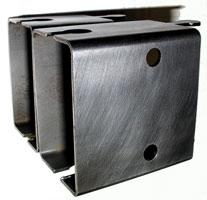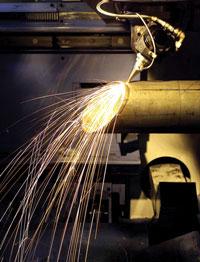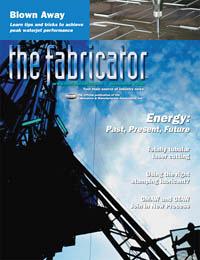- FMA
- The Fabricator
- FABTECH
- Canadian Metalworking
Categories
- Additive Manufacturing
- Aluminum Welding
- Arc Welding
- Assembly and Joining
- Automation and Robotics
- Bending and Forming
- Consumables
- Cutting and Weld Prep
- Electric Vehicles
- En Español
- Finishing
- Hydroforming
- Laser Cutting
- Laser Welding
- Machining
- Manufacturing Software
- Materials Handling
- Metals/Materials
- Oxyfuel Cutting
- Plasma Cutting
- Power Tools
- Punching and Other Holemaking
- Roll Forming
- Safety
- Sawing
- Shearing
- Shop Management
- Testing and Measuring
- Tube and Pipe Fabrication
- Tube and Pipe Production
- Waterjet Cutting
Industry Directory
Webcasts
Podcasts
FAB 40
Advertise
Subscribe
Account Login
Search
Fabricator finds tubular niche
Job shop uses laser cutting to complement CNC machining
- November 7, 2006
- Article
- Tube and Pipe Fabrication
Although Illinois is known primarily for its fertile fields and agricultural output, it's home to many manufacturing companies too. John Deere incorporated Deere & Co. in Moline. DaimlerChysler manufactures automobiles in Belvidere. Caterpiller's worldwide headquarters is in Peoria.
Where manufacturers set up shop, fabricators thrive. One such fabricator, Production Cutting Services, was established in 1985 in East Moline specifically to serve the OEMs in the area.
"We started out as a saw cutting operation to supply cut-to-length tubes to the big agricultural equipment companies," said owner and founder Bill Duy. "It wasn't long afterward that we recognized the need to add more value to survive."
Value came in the form of milled contours, drilled holes, and other part features made by CNC machining centers. Although the machines are sophisticated and capable, machining centers face a few hurdles in processing this fabricator's tubular parts.
Setup and processing time are two of the hurdles. One challenge was a part made from 4-in. by 4-in. by 0.25-in. square tube. It had holes on all four sides that had to be ±0.010 in. relative to each other.
"First we'd cut it to length," Duy said. "Then we'd bring the pieces to the machining center where there were two vises. Each vise held the part for two positions and the machine was programmed to drill a side for each position. After each side was finished, the operator had to stop and turn the tube to the next side. So not only were there four steps per piece, the operator deburred the inside of each tube with a hand tool. And if the operator rotated the part the wrong way, it was scrap."
Drilling had some inherent difficulties.
"Once the drill makes contact with the tube, the tube walls begin to vibrate and flex," Duy explained. "Not only does it cause burrs, it can affect the accuracy to the extent that I've seen a round drill cut a triangular hole in tube. Plus, vibrations can ruin tooling, damaging a $500 tool in a matter of seconds."
Searching for a Faster, Smoother Cutting Process
By 2002 the company was ready to try a different cutting method, so it purchased a 2,500-watt SG-U44 rotary laser from Mazak Optonics Corp. and a 4,000-W FabriGear 300 from the same manufacturer two years later.
"We've gone through a metamorphosis," Duy said. "We really underestimated how much setup time, part handling, and machine idle time was costing us. Now, when the material is on the laser, it's making parts."

Typical laser-cut features include cuts and holes. Production Cutting Services found that making holes on a laser improved accuracy and reduced setup time by at least 50 percent.
Duy called the laser capability a "lean engine" for his company because it has sped up processing, decreased operator involvement, and freed up capacity for new business. "We're not walking away from CNC machining," he said. "On the contrary, with large OEMs continuing to pare down vendors, we want to keep giving our customer base as wide a range of processing choices as possible."
That said, lasers have absorbed the majority of Duy's tube processing, and for good reason. On the aforementioned square part, the operator simply fastens the tube to the SG-U44's rotary chuck and the machine does the rest. The operator doesn't need to turn the part, deburr it, or bevel it.
"We went from four setups to one, and the cycle time was reduced 50 percent to 60 percent," Duy said. Because the laser also cuts off the part, a single 10-foot tube yields several parts.
A Look Backward, a Step Forward
Over the last four years, sales have more than doubled at Production Cutting Services and the company plans to continue expanding.
"Ag and construction equipment markets are good at present, but we see a lot of growth potential in more thin-walled tubing for office equipment, gyms, trailers, and other applications," Duy said. He has his CNC equipment set up in cells to accommodate castings, forgings, and other materials less suited to lasers.
"We've created a company that's capable of supplying a variety of parts fabricated to customer specifications, and there's room to grow," Duy said.
Related Companies
subscribe now

The Fabricator is North America's leading magazine for the metal forming and fabricating industry. The magazine delivers the news, technical articles, and case histories that enable fabricators to do their jobs more efficiently. The Fabricator has served the industry since 1970.
start your free subscription- Stay connected from anywhere

Easily access valuable industry resources now with full access to the digital edition of The Fabricator.

Easily access valuable industry resources now with full access to the digital edition of The Welder.

Easily access valuable industry resources now with full access to the digital edition of The Tube and Pipe Journal.
- Podcasting
- Podcast:
- The Fabricator Podcast
- Published:
- 04/16/2024
- Running Time:
- 63:29
In this episode of The Fabricator Podcast, Caleb Chamberlain, co-founder and CEO of OSH Cut, discusses his company’s...
- Trending Articles
AI, machine learning, and the future of metal fabrication

Employee ownership: The best way to ensure engagement

Dynamic Metal blossoms with each passing year

Steel industry reacts to Nucor’s new weekly published HRC price

Metal fabrication management: A guide for new supervisors

- Industry Events
16th Annual Safety Conference
- April 30 - May 1, 2024
- Elgin,
Pipe and Tube Conference
- May 21 - 22, 2024
- Omaha, NE
World-Class Roll Forming Workshop
- June 5 - 6, 2024
- Louisville, KY
Advanced Laser Application Workshop
- June 25 - 27, 2024
- Novi, MI



























